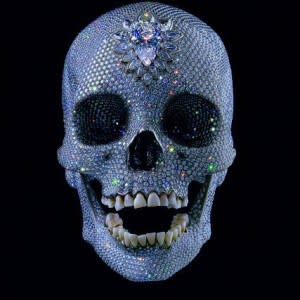Time and again, British Pop Artist Damien Hirst has demonstrated that when it comes to Contemporary Art, no subject is out of bounds. In fact, if there's a subject that's typically deemed "out of bounds" by the mores of our modern society, such a subject is most certainly inbounds for Hirst. Death, in particular, is a consistent theme that is contemplated when viewers consume the works of Damien Hirst. For the Love of God, one of the artist's most famous works, is as controversial today as it was when the sculpture was first unveiled in 2007.
Damien Hirst has attributed the title of this work to the exclamatory statement his mother would make each time he shared his intention for new projects as a young artist, "For the love of God, what are you going to do next!" Evidently, such a level of concern proved to be an ample barometer that Hirst was on the right track, creating art that would generate strong opinions - one way or the other. For the Love of God is appropriately "over the top," meaning it's on par for an artist who has shocked people with grand installations of dead and decomposing animals for decades.
Whereas it the polarized opinions about the value of previous Hirst works is understandable, this sculpture raises the bar by virtue of the fact that the raw materials are of high worth by the their very nature. 8,601 diamonds that rated as VVS to flawless, weighing a combined 1,106.18 carats, set in a platinum skull mold ensure that this work is comprised of a staggering value of components - regardless of where one stands on its artistic value. It should be noted that the teeth placed within the jaw are real and belonged to the original skull, which was purchased by Damien Hirst from a taxidermist in London.
As if the presence of diamond encrusted skull did not carry enough emotional weight, the timing of this work's unveiling added increased speculation. Some feel that Mr. Hirst timed the sculpture's announcement to coincide with former president of Liberia, Charles Taylor's appearing before an international panel of judges to stand trial for war crimes committed in Sierra Leone. The war crimes were tied to the mining and selling of West African diamonds to fuel the purchase of weapons. These diamonds had become known as blood diamonds. Damien Hirst has presented evidence that the diamonds used within his sculpture are proven to be ethically sourced. Nonetheless, the timing certainly brought additional controversy and potential meaning to For the Love of God.
Understanding the profound nature of this diamond skull, Damien Hirst also created a series of limited edition silkscreen prints in 2007, including a series of 250 made with diamond dust. Taking the "lifelike" nature of printmaking to a new level, Hirst created a series of digital lenticular prints in 2012 that produce a remarkable three dimensional likeness that must be seen to be appreciated for its fine details.
If you are a Damien Hirst collector seeking works by the artist, feel free to contact us for assistance. If you are in the vicinity of our Boca Raton Contemporary Art Gallery, stop in and see a number of fine Damien Hirst limited edition works for sale.



